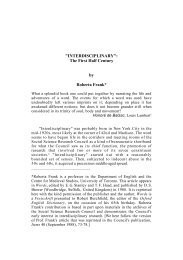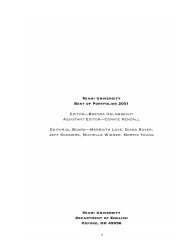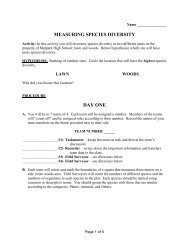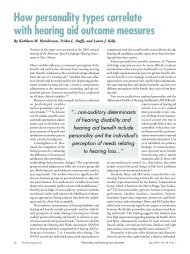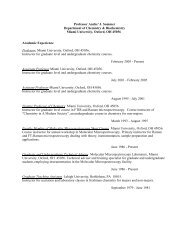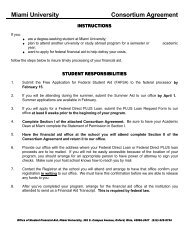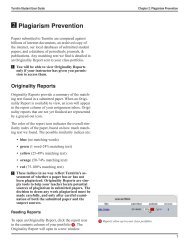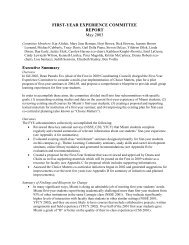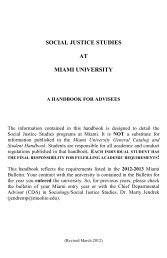Interdisciplinary Research Manual - Units.muohio.edu
Interdisciplinary Research Manual - Units.muohio.edu
Interdisciplinary Research Manual - Units.muohio.edu
Create successful ePaper yourself
Turn your PDF publications into a flip-book with our unique Google optimized e-Paper software.
35<br />
the challenges they face differ, depending on the state of scholarly understanding of the<br />
topic. Those topics that the disciplines are just starting to address present you with the<br />
challenge of inventorying and organizing fragments of insights from various scholars to<br />
take away some of their randomness and identify some preliminary patterns, maybe even<br />
developing some theory of your own. Topics that scholars have mulled over for years<br />
present the challenge of reassessing well-established ways of understanding in light of<br />
insights emerging from your new, more comprehensive understanding. Topics early in<br />
the academic lifecycle are likely to start from preliminary, low-level theory at best, and<br />
there may be no agreement in the professional literature on the definitions of terms;<br />
topics later in the lifecycle are more likely to be understood through theory that has taken<br />
on the status of unassailable truth expressed in terms whose definition has become selfevident.<br />
One location in the lifecycle is not preferable to another; the challenges for your<br />
project are merely different. The earlier in the life cycle you encounter the topic, the<br />
sketchier your new understanding will be, and the more it will focus on defining concepts<br />
and developing a new theoretical framework. Later in the life cycle, the more developed<br />
and nuanced your understanding can become, and the more it will focus on modifying<br />
existing concepts and theories. No matter where you are in the life cycle, the essential<br />
challenge to the interdisciplinarian remains the same, to come up with a new way of<br />
thinking that draws on the insights of contributing disciplines.<br />
Fourth, you need to identify the relevant “contexts” for your project. The context<br />
of your topic can take a number of different forms. It might refer to placing social<br />
behavior in economic, political, cultural, geographical, historical context; to placing<br />
chemical phenomena in geological, biological, and evolutionary context; or to placing<br />
theatre in the context of film, art, and music. It might involve placing individual behavior<br />
in the context of family, peer-group, community, nation, race, gender, and culture;<br />
placing phenotypes or species in the context of eco-systems; or placing characters in the<br />
context of comparative literature or other media. It can place the study of a particular<br />
social phenomenon such as raves in the context of other sub-cultures, youth cultures,<br />
countercultures, music scenes, drug scenes, social deviance, or minority groups. In<br />
general, to identify the relevant contexts for your topic, ask what larger categories or<br />
groups it is a part of, an instance of, an example of. Start with those larger categories—<br />
e.g., sub-cultures in general—before trying to apply the concepts and theories,<br />
approaches, questions, underlying values, and strategies you find in the literature to the<br />
particular sub-culture you are interested in. In general, all interdisciplinarians face the<br />
problem of taking something written for one context and applying it to another context.<br />
The difference is one of degree—just how much you need to alter a concept or theory to<br />
fit the new context.<br />
Fifth, size up the likely appeal and mission of your project. Is its appeal to<br />
readers—its distinctive contribution—likely to be intellectual and academic, or emotional<br />
and personal? Is the mission of your project likely to be persuasion or exploration? Your<br />
answers to these questions will obviously depend in part on your intentions, but they will<br />
also be determined by where your topic is in the academic lifecycle and on the contexts in<br />
which you can place it.<br />
Once those five tasks are completed, you are ready to come up with an outline<br />
that lays out a tentative structure for your project. In your outline you need to identify the<br />
overall focus of each chapter and the order of the chapters. Then you need to go back and



